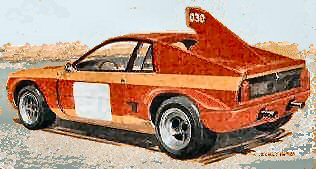Introducing
Pininfarina's X1/8-X1/20
A big issue
with mid-engined sports cars is how to make enough revenue to recoup
the initial investment. The three box, engine in the rear design of
body tends to be expensive on materials and complex to produce. This
is not so bad if you build an all out rally burner like the Stratos,
when a few hundred are needed for homologation. But a full production
sportscar carries more risks.
Fiat's solution
was to sell this car under the Lancia badge to attract a price premium.
It was at the Geneva Motor Show in 1975 that Lancia launched this new
sports car - the Lancia Stratos had just 'cleaned up' on the Monte Carlo
Rally - so the new Beta was called Montecarlo - a famous name indeed.
When I originally
learned this car was the first to be completely built by Pininfarina
I was surprised. It lacks a certain subtlety of curve and line I would
normally associate with their designs. Perhaps my eyes are too used
to their many fine Ferrari forms. Yet in 1975 the Montecarlo won several
style awards. The first series were named Beta Montecarlo, but the 'Beta'
was dropped later on.
Precisely were
would this mid engined sports coupe fit in the Fiat/ Lancia sports car
ranges? Fiat's coupes are always 4 seaters, so despite the 124 CC and
Fiat 130 coming to the end of their lives, substituting a mid engined
coupe was not possible. The Lancia Beta range already had the successful
Beta Coupe too. Perhaps this explains why this design had taken so long
to come to production. Early prototyping studies of the Montecarlo certainly
pre-dated the X1/9. Yet the exxie had gone into production years before
it.
So in the seventies
'open topped' sports cars Fiat had the 124 Spider and X1/9 with its
targa. Again it is not clear where the Montecarlo fits in. To succeed
in sales terms in 1975 sports cars had to sell well in the States. Both
the Fiats were in demand there. This highlights a second problem for
the Montecarlo - its performance. When compared to the X1/9 it was sluggish.
The Monte has a slightly better top speed, but in all other ways - including
fuel consumption - it barely matched its cheeper underling. As the States
emissions controls rolled in, and the X1/9 got a 1500cc engine, the
situation only got worse. So naming the car 'Scorpion' in the States
was more about marketing hype than reality.
Was the Montecarlo
ever intended to have the Fiat 130's V6 engine? Well not by the time
Pininfarina were involved. The V6 (with expensive Stratos transaxle)
could not have been accommodated using their unitary build and design
techniques. Yet the joint project with Abarth on the 030 Prototype did
have the Fiat 130 V6 installed.
Now I'd like
to turn these points around. The Montecarlo is a thoroughly viceless
and rare machine. They need more power to go as well as their looks
promise. But as the car was equipped with the 2Litre Fiat/Lancia Twin
Cam, finding sufficient is no real problem at all! Today, providing
they are well restored or rust free, Montecarlos make an eye catching
classic sports car. Few people will know what you are driving. You'll
find waiting to pull out into traffic gaps frustrating, as the last
car before the gap slows down to take a good look at you.
Inside the
Monte is well appointed. All but the first few had a leather interior.
You can acquire interiors if necessary as there were enough sold to
make second hand spares a possibility. Driving the Montecarlo is pleasant
and rewarding, and apart from the slightly slow gear change these cars
have few bad points. You'll find the road holding and road manners good.
On the move there's a lot more noise and vibration than in today's sports
cars, yet the car's ventilation is adequate in all but the hottest weather.
Like the X1/9 it gets hot on long journeys - but an air conditioning
option was available and in the UK we rarely suffer humidity levels
that would preclude opening a window!
History
The Series
1 Beta Montecarlo was produced between 1975 and 1978 by Pininfarina.
And there was a delay of about 9 months before the first right hand
drive versions were available on both the first and second series.
In 1978 production
was suspended, while Lancia conducted an upgrade of the car. The 13inch
wheels were replaced with 14inch and larger brake discs used. The troublesome
front brake's servo was removed. Power remained at 120bhp from the 2
litre unit, but torque was increased throughout the rev range. Both
front and rear tracks were increased by 10mm on lower profile tyres.
Grills and badges were changed, and the Beta prefix was dropped from
the name so it became the Lancia Montecarlo. The revised model was introduced
at the Geneva Motor Show in 1980, exactly five years after its first
launch there. "..a superb sportscar" trumpets the publicity
from the launch.
I think its
time this classic received more of the recognition it so justly deserves.
Meanwhile,
back in late 1980, plans were afoot from Lancia and Abarth to begin
a world rally championship makeover of the Montecarlo. This was to become
the 037.
Up
The Performance Ladder
Competition
breeding has never been far away from the Montecarlos as the table suggests
they have had a lot to do with the seventies and eighties Factory Twin
Cam developments..........
| Factory
Specifications |
| Year |
Model |
cc |
Head(s) |
Induction |
Use |
Output |
| 1972 |
030 Abarth Prototype |
3litre
V6 |
8
valve |
Carb |
Prototype |
250bhp |
| 1974 |
Lancia Beta Coupe |
1756 |
8 valve |
Carb |
Rally |
180bhp |
| 1974 |
Lancia Beta Coupe |
1756 |
16
valve |
Carb |
Rally |
190bhp |
| 1975 |
X1/9 Prototipo Abarth |
1840 |
16 valve |
Carb /ie |
Rally |
195bhp |
| 1976 |
Fiat 131 Abarth |
1995 |
16 valve |
Carb |
Rally |
210bhp |
| 1979 |
Fiat 131 Abarth |
1995 |
16 valve |
i-mech |
Rally |
230bhp |
| 1978/9 |
Beta Montecarlo |
1426 |
16
valve |
Turbo
ie |
Sports
racer |
370-450bhp |
| 1980 |
Beta Montecarlo |
1995 |
16
valve |
VX
ie |
Sports
racer |
300bhp |
| 1981 |
Beta Montecarlo |
1773 |
16
valve |
2
Turbo ie |
Sports
racer |
490bhp |
| 1982 |
Lancia
037 Abarth |
1995 |
16
valve |
VX
ie |
Rally |
280-310bhp |
| 1984 |
Lancia 037 Abarth |
2111 |
16
valve |
VX
ie |
Rally |
325bhp |
| 1986 |
Lancia ECV |
1759 |
16 valve |
2 Turbo ie |
P-type Rally |
600bhp |
| |
The table demonstrates
some of the key milestones in competition car performance by Abarth,
Fiat and Lancia. The Montecarlo has been used as the basis for motorsport
throughout 15 years, with the cars using the Montecarlo chassis listed
enboldened.
It is the continued
development of the 4 cylinder twin cam engine that links most of this
development - and mainly through Abarth - the step by step improvements
being made. While the Bertone designed and inspired Stratos was sweeping
all before it, Lancia were still fielding the Beta Coupe
Background
on the Montecarlo
Some of Fiat's
famous 'X' code development projects take time coming to full maturity.
And the Montecarlo is one of the longest. During the sixties, Fiat had
experimented with front wheel drive transverse engine designs, themselves
based on the '123' prototype projects of 1958-59. This led from the
1964 Autobianchi Primula and on to the Fiat 128 and X1/9 in the 1970's.
The X1/8 and
X1/9 projects used a transverse engine layout from a front wheel drive
design, but placed at the rear of the car. This gives a mid engined
layout in a 'three box' body monocoque, with the gear box linkage being
operated from in front of the engine. The X1/9 project retained its
development code into production - mainly due to the persistence of
Nuccio Bertone.
Bertone had
convinced Fiat to adopt this layout for the 128 range sports car, rather
than the traditional front engined replacement for the 850 Spider they
had expected. The Bertone design itself followed closely on that for
the Lancia Stratos and Lamborghini Miura - and Bertone funded the build
of the Runabout (or 'Barchetta' - 'Little Boat') prototype to help demonstrate
the viability of the mid engined design. In 1970 full production design
began... and the X1/9 name was retained partly to distance the sports
car from close association with the 128 range.
The Montecarlo
derives from a second line of development started before the X1/9, looking
at the design options for a medium size sports car. The world's positive
reaction to the Stratos had been much greater than expected within Fiat.
And this had removed some doubts about wedge shaped mid engined sports
cars. So the G.21 prototype that extended into the X1/8 project era
in the sixties and had been extended into the X1/20 project was 'dusted
off' again.
Some versions
of this development used Fiat's famous Twin Cam engine. And convinced
that the day of the classic wedge shape had arrived, Fiat eventually
gave the development task to Pininfarina. The final decision was to
more closely associate the car with the Stratos' competition succes
by naming it after the rally that the Stratos had dominated.
The Montecarlo
was put into production during 1974 and officially launched early in
1975 at the Geneva Motor Show. During this phase the engine choice was
also settled, as V6 Ferrari power (like the Stratos) had been an option.
In the 1972 Giro d'Italia (Tour of Italy) a prototype (Abarth - Pininfarina
030 An artists impression of the Abarth 030 can be seen here)
had finished second to a Stratos. But in 1974 the Fiat Lancia Twin Cam
was selected. The Lancia Montecarlo was to be the first production car
to have a 2 litre capacity version.
Abarth
030 Spec

Engine:
Fiat 130 V6, 3481cc
Position:
Mid engined longitudinal
Bore
& Stroke: 102x71mm
Power:
285bhp @ 6000rpm
4
valves per cylinder
Wheels
front: 9jx13inch rear: 12jx13inch
Track
front: 1516mm rear: 1596mm
Body
length 2296mm
Weight
910kg
Numbers
Produced
| |
Series
1 |
|
| Beta Montecarlo |
Left hand drive |
3046 |
| |
Right hand drive |
789 |
| |
Total |
3835 |
| |
Series
2 |
|
| Montecarlo |
Left hand drive |
1515 |
| |
Right hand drive |
452 |
| |
Total |
1967 |
| |
Scorpion
(USA) |
|
| Scorpion Spider |
Left hand drive |
1801 |
| |
Total |
1801 |
| |
Grand Total |
7603 |
Links
Clubs and
info
American Lancia
enthusiasts http://www.americanlanciaclub.org
Enthusiasts
in Germany
Good Italian
site with useful links http://www.betamontecarlo.it
New Montecarlo
Prototype model
Lancia 037
site
Parts &
Advice
Like the Fiat
124s and other seventies Italian sports cars, finding spares for the
Montecarlo has never been easier. More parts with consistent quality
are available today than for the last twenty years.
Betacar
Fiat and Lancia parts specialist in Bradford West Yorkshire on 01535
275560.
US based
parts with connections to Bruce's Parts Bin too.
Omicron
Engineering in the UK. Omicron Engineering have established a good reputation
for supplying all the Lancia parts.
The Monte Hospital
in Herefordshire have steadily built up parts and performance tuning
lists for your Montecarlo. Check out Monte
Hospital for spares and advice.
More parts
advice from the States from
one of the oldest sites started By Huib Geurink back in 96!

